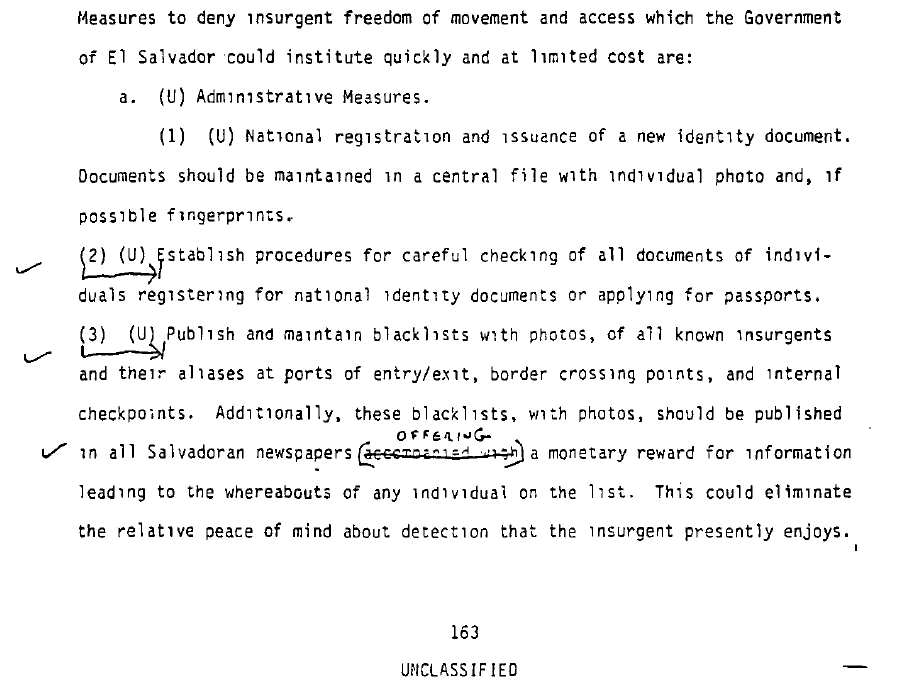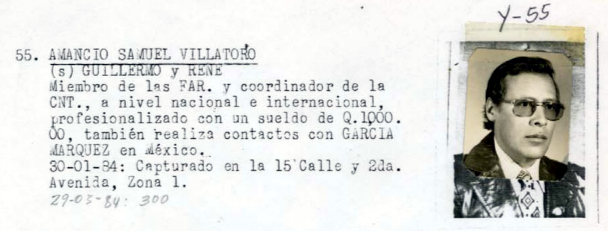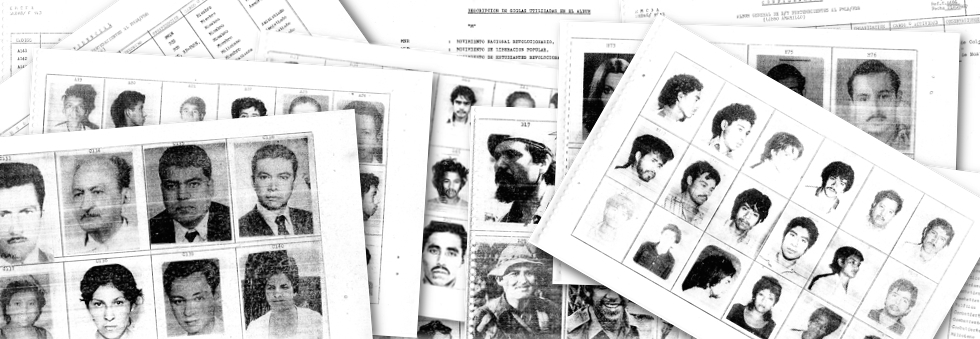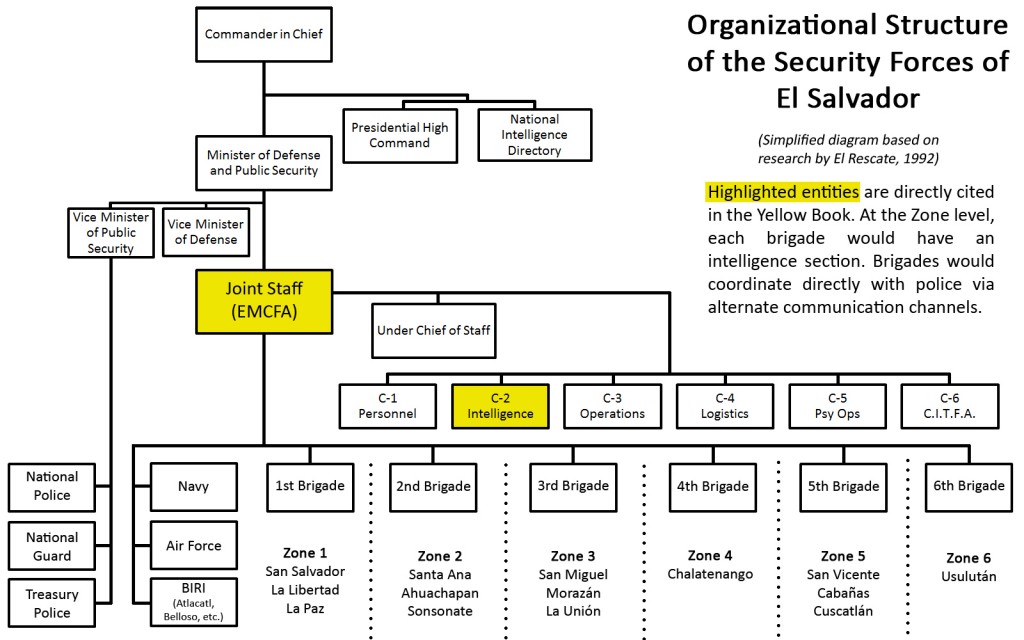MILITARY INTELLIGENCE AND THE YELLOW BOOK
“Know your enemies”: How the Yellow Book was used
The Yellow Book is an intelligence product, a compilation of information fed into a centralized database maintained by the Army General Staff’s C-II intelligence section. Among the units likely to have contributed to it were the intelligence divisions of the Air Force, National Police, National Guard, and Treasury Police, among others, as well as the different layers of intelligence within the Salvadoran Armed Forces (such as the S-II sections operating at the military zone, brigade and battalion levels). A handwritten note on the cover instructs: “Use it. Make copies of the photographs and put them on your bulletin board so you will know your enemies.”
The Yellow Book’s introductory note, “Format and Codification,” outlines the organization of the report and explains that it was intended to assist in the identification of targets by military units in the field, standardize how information about suspects was communicated by radio and telephone, and centralize the collection of emerging intelligence on unidentified suspects by military intelligence, section C-II of the Joint Staff of the Armed Forces (EMCFA). “Phase C” of the list (unidentified individuals or people identified only by pseudonyms) is included “so that any unit that manages to obtain information about any individual among them would send it to the C-II of the EMCFA for the corresponding application.” The book’s structure, it continues, “facilitates the presentation of photographs of the subjects, without giving information/names,” suggesting that the book may have been used during questioning or interrogations. Despite these guidelines, it remains unknown precisely how the Yellow Book was used in the field.
Notably, the cover of the Yellow Book includes annotations referencing “COMMAND HEADQUARTERS” and “ARCHIVE D-II”. “D-II” is likely an anachronistic reference to the “Departmental” organizational structure within the EMCFA, which was superseded in the 1980s by a “Joint” (“Conjunto“) model with the equivalent designation “C-II”.[i]
The following diagram is a simplified illustration of the organizational structure of the Salvadoran security forces during the late 1980s, based on research published in 1992 by the Salvadoran-American NGO El Rescate. Highlighted entities are directly mentioned in the Yellow Book. At the Zone level, each brigade would have an intelligence section (designated “S-II”). Brigades would coordinate directly with the police via alternate communications channels.
In an interview conducted in 1987, former C-II director Col. Juan Orlando Zepeda described in detail how the Armed Forces Intelligence Section was structured.[ii] According to Zepeda, the C-II contained several different task-oriented groups, including the Intelligence Roster, Immediate Analysis, and Interception of Technical Signals groups, as well as a general counter-intelligence group, and an operations section, comprised of a document analysis unit and a unit for interrogation procedures. The Armed Forces Joint Staff provided instructions for the mobilization of the C-II groups.
The emphasis in the Yellow Book on the use of intelligence to identify not only guerrilla combatants but “enemy” civilians corresponds with the findings of human rights investigations conducted over the years. The United Nations Commission on the Truth for El Salvador (UNTC) report, From Madness to Hope: The 12-Year War in El Salvador, for example, indicated that dating back to the 1960s, “[National security] institutions helped consolidate an era of military hegemony in El Salvador, sowing terror selectively among alleged subversives identified by the intelligence services. In this way, the army’s domination over civilian society was consolidated through repression in order to keep society under control” (p125). The commission urged that Salvadoran intelligence agencies be targeted for reform as part of the post-war process of peace and reconciliation.
“It is especially important,” concluded the UNTC report, “to call attention to the repeated abuses committed by the intelligence services of the security forces and the armed forces. It is crucial for the future of El Salvador that the State pay attention to the use of intelligence services and to the exploitation of this arm of the Government to identify targets for murder or disappearance. Any investigation must result both in an institutional clean-up of the intelligence services and in the identification of those responsible for this aberrant practice” (pp129-30).
The UN Truth Commission identified military intelligence with a proliferation of death squad activities. According to the UNTC report, “In many armed forces units, the intelligence section (S-2) operated on the death squad model. Operations were carried out by members of the armed forces, usually wearing civilian clothing, without insignias, and driving unmarked vehicles.”
Death squad operations were also carried out at the national level: “The Intelligence Section had subsections such as operations and intelligence. Within the intelligence sub-section, there was a smaller group in charge of ‘dirty work’, which specialized in interrogations, torture and executions.” Within the C-V (Civilian Affairs Section) of the Armed Force General Staff as well, the report found, the military maintained “a secret, clandestine intelligence unit for the surveillance of civilian political targets, which received information from the S-2 sections of each military unit or security force. The purpose of this unit was to obtain information for the planning of direct actions that included the ‘elimination’ of individuals. In some cases, such plans were transmitted as actual orders to operational units in the various security forces or the armed forces themselves.”[iii]
Individuals listed in the Yellow Book were also targeted by the death squads. For example, a 1980 communique signed by the “Secret Anti-Communist Army,” a coalition of seven extreme right-wing terrorist groups, circulated a “blacklist” of more than 200 names, at least 32 of which also appear in the Yellow Book.
The fingerprints of the United States
U.S. security assistance flowed to the El Salvador counterinsurgency effort throughout the war, totaling some $5 billion by 1992. It included millions of dollars for enhanced intelligence gathering. While there is no direct evidence suggesting that the U.S. was involved in the creation of the Yellow Book, the extensive material and operational support provided by the U.S. to the Salvadoran intelligence services touched on themes central to the Yellow Book.
The blueprint for the U.S. security program was developed by Brigadier General Fred Woerner, when he headed a U.S. military team to El Salvador to carry out an assessment of the government’s war strategy for the new Reagan administration in 1981. The report that resulted in November of that year proposed a massive injection of U.S. military aid to help the Salvadoran security forces win what the report called a “strategic victory.”
One of the Woerner team’s primary concerns about the armed force was its weak military intelligence capacity, calling “The absence of good intelligence and the derivative understanding of enemy capabilities and intentions… a particularly limiting factor.”[iv] To remedy the shortcomings in Salvadoran intelligence, the Woerner team recommended intelligence training, dedicated intelligence equipment, and the creation of an intelligence communications net.
One means recommended by Woerner to separate the insurgents from their base among the Salvadoran people and to identify militant supporters was the creation of “population control measures.” The Woerner Report proposed the establishment of a national registry and new national ID document, to be maintained in a central file with photo and fingerprints, and advised that the military “Publish and maintain blacklists with photos of all known insurgents and their aliases at ports of entry/exit, border crossing points, and internal checkpoints.”[v]

In the years that followed the Woerner team’s assessment, U.S. security assistance soared, including support for all aspects of the Salvadoran intelligence apparatus. While the Directorate of National Intelligence received external aid from the CIA, the C-II worked most closely with the U.S. Military Group (USMILGP) and the Central America Joint Intelligence Team, or CAJIT, according to its director, Colonel Juan Orlando Zepeda.[vi]
Created by the U.S. Defense Intelligence Agency (DIA) in 1983, CAJIT was an intelligence “fusion center” of almost 100 U.S. military and intelligence analysts – including officers from the CIA and National Security Agency – working from the Pentagon to provide strategic and tactical intelligence to the U.S. Southern Command in Panama and U.S. allies in the region.[vii] As described in a 2011 DIA internal history, CAJIT “used powerful databases and improved communications technology to quickly analyze and disseminate intelligence used in U.S. support of the Salvadoran military as a way to improve its operations against the insurgents.”[viii]
U.S. aid to Salvadoran military intelligence through CAJIT and the MILGP was for the most part centered on improving human intelligence, or “HUMINT,” especially at the brigade level, according to Colonel James J. Steele, commander of the U.S. Military Group in the mid-1980s. “In an insurgency the principal focus has to be on human aspects,” he told an interviewer in 1986. “That means agent networks. That means getting people to talk to you.” Particularly important, Steele added, was identifying insurgents by name. “You do ground work, and you find out that in the sector that you are going into, there may be 50 guerrillas. You know that there are 50 because you have their names, the order of battle, and you know how they’re equipped, and so on. It just makes it an awful lot easier to go in there and deal with them.”[ix]
Military intelligence lists across the Americas
The Yellow Book corresponds to a common practice among Latin American armed forces during the cold war of compiling lists of insurgents and civilians believed to be their supporters. Military and police intelligence used the lists to track perceived enemies of the State and often to detain, disappear or assassinate them. Lists were also a form of record keeping, a way of maintaining archival control over suspected subversives – whether they were targeted for capture, already detained, or dead.
The notorious Diario Militar, or “death squad dossier,” of Guatemala, for example, contains two lists compiled by a Guatemalan army intelligence unit during the mid-1980s that share characteristics found in the Yellow Book. One is an internal registry of the intelligence folders held on 164 individuals, organized by number, name in alphabetical order, and pseudonym. In addition to serving a similar function – providing authorities with a formal classification system for intelligence gathered on identified subversives – the Guatemalan and Salvadoran records also use a similar lay-out and capitalization:
From the Diario Militar:
![]()
From the Yellow Book:
![]()
The Diario Militar includes a second record of suspected militants that shares elements found in the Yellow Book. More than a simple list, the record contains brief entries on the capture and (in most cases) disappearance of 183 individuals allegedly linked to the guerrillas. Each entry includes identifying information (names, pseudonyms), the date and circumstances of their capture, and a second date indicating their fate (executed, turned over to another intelligence unit for detention and interrogation, or released).
Like the Yellow Book, the Diario Militar contains victim photographs that were taken from personal identification cards (municipal ID, driver’s license, university ID) and inserted into the book; whether they were included for identification purposes or as proof of capture is unknown. Like the Yellow Book, the Diario Militar identifies militants by their faction within the revolutionary movement, and references any travel to communist countries. Like the Yellow Book, the Diario Militar was the work product of military intelligence that appears to have served a dual purpose: as a registry of subversives already “processed” (that is, whose fate had been determined by the authorities and carried out), and as a working intelligence document that was constantly consulted, amended, updated, and corrected (often by handwritten notes) as new intelligence came in on the guerrilla networks under surveillance.

The remains of five victims of disappearance registered in the Diario Militar have been identified in recent years, including those of Amancio Samuel Villatoro, pictured above. The bodies were recovered in exhumations carried out at a former military base by the Guatemalan Forensic Anthropology Foundation (FAFG).
Other intelligence documents compiled by Latin American counterinsurgent militaries and collected in the National Security Archive contain features similar to those found in the Salvadoran Yellow Book, including records from Uruguay, Argentina, and Colombia. Taken together, they provide strong evidence that the Yellow Book was the product of a modus operandi shared by military intelligence institutions of the Americas during the cold war.
BACK TO THE YELLOW BOOK MAIN PAGE
Notes
[i] Brian J. Bosch, The Salvadoran Officer Corps and the Final Offensive of 1981, (Jefferson, NC: MacFarland & Company, Inc., Publishers, 1999), 78’79. A former U.S. Defense Attaché in El Salvador, Bosch discusses an early stage of this transition with the establishment of the Centro de Operaciones Conjuntas de la Fuerza Armada (COFCA) in 1980, stating that, of the departments of the General Staff, the D-II “utilized the COFCA to the fullest in January 1981.” However Bosch does not discuss or provide a date for the transition from “D-II” to “C-II” nomenclature.
[ii] Max H. Manwaring and Court Prisk, ed., El Salvador at War: An Oral History of Conflict from the 1979 Insurrection to the Present, (Washington, DC: National Defense University Press, 1988), pp. 312-13. Col. Zepeda was head of the C-II from 1985-87, and was interviewed on January 22, 1987. In 1992, the UNTC report named him as one of the senior military officers who ordered the 1989 assassination of Jesuit priests.
[iii] Op. cit. UNTC, IV. Cases and Patterns of Violence, D. Death squad assassinations, 2. The Death Squad Pattern, pp. 128-9 in U.S. Institute for Peace posting.http://www.usip.org/sites/default/files/file/ElSalvador-Report.pdf
[iv] Brigadier General Fred F. Woerner, Report of the El Salvador Military Strategy Assistance Team (Draft), Department of Defense, November 1981, p. 17.http://www.dod.mil/pubs/foi/International_security_affairs/latinAmerica/460.pdf
[v] Ibid, p. 163
[vi] Op. cit. Manwaring and Court, p. 311.
[vii] Charles Francis Scanlon, In Defense of the Nation: DIA at Forty Years (Washington, DC: Government Printing Office, 2002), 141. Cited in James D. Marchio, The Evolution and Relevance of Joint Intelligence Centers: Support to Military Operations, Apr 15, 2007 (See CIA Center for the Study of Intelligence, https://www.cia.gov/library/center-for-the-study-of-intelligence/csi-publications/csi-studies/studies/vol49no1/html_files/the_evolution_6.html)
[viii] DIA, History: 50 Years of Excellence in Defense of the Nation, (Washington, DC: Defense Intelligence Agency, Historical Research Support Branch, 2011), p. 30.http://www.dtic.mil/dtic/tr/fulltext/u2/a536892.pdf
[ix] Op. cit. Manwaring and Prisk, pp. 314-16. Col. James J. Steele was commander of the USMILGP from 1984-86. He was interviewed on October 5-10, 1086 and again on November 5, 1986.

